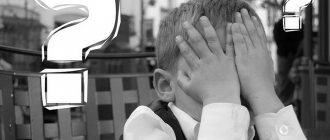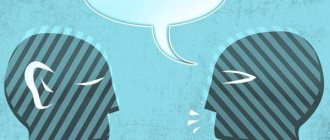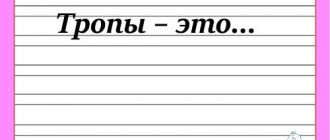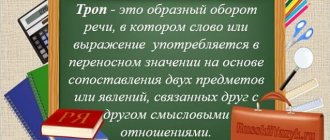The speaker and listener may not even be aware of the role of tropes in the Russian language, but actively use artistic means and perceive their dual meaning.
You don’t have to be a writer to understand the message of the phrase “pig in a poke.” But the simple man in the street will not always answer the question of what it is - “a pig in a poke”.
Defining Tropes
Tropes are the main stylistic figure designed to enrich the expressiveness of language, to embody a game with the reader through figurative thinking, enhanced expression and figurative meanings.
These include comparisons, exaggerations, epithets and other lesser-known expressions such as alliteration. It is often expressed in the form of an adjective or participle, answering the question “which?” But it can also act as a noun: spring beauty.
A narration, decorated with various techniques, arouses much more interest than a dry listing of facts, actions, names of heroes, and meager descriptions of their character.
And even in the most primitive conversations, willy-nilly, you can detect people’s desire to embellish and compare.
This is found everywhere along with syntactic and lexical means:
- In any kind of text, be it free stories, scientific articles or poems.
- In living human speech (the most common phraseological units).
- In folk art. It is mainly built on inversion, grotesque, set phrases and a colossal number of epithets.
There are quite a lot of artistic techniques, sometimes it is difficult to distinguish them from each other even for experienced literary critics. But general stylistic devices are not that complicated.
What is allegory: examples in literature
Allegory can be considered a feature of literature as an art form. Entire works are built on this principle. Russian folk tales, Aesop's fables, Garshin's stories, Maeterlinck's plays, Wilde's fairy tales were created through this special language. It is examples from literature that will help reveal the meaning of the concept of allegory. In Shchedrin's fairy tale "The Horse" there are allegorical images of horses as representatives of different classes. In folk songs, a married couple is likened to a pair of birds: doves, peacocks or falcons.
In lyrical works this feature of literature is found even more than in prose. The poet Gennady Aiga has allegory in every word. His poems are like a code that not every person can solve. The author, whose lines are even more allegorical than those of Gennady Aiga, is Vladimir Kazakov. There is no integrity in his works, but there is an endless repetition of words and images. For example, “mirror”, “clock”, “tea” are found very often in his creations, often changing their meaning.
Allegory is most clearly manifested in fantasy. The authors of such works convey real life phenomena through fiction. The use of numerous allegory techniques allows you to visually and figuratively convey what happened thousands of years ago or will happen in the future.
Main types
| COMPARISON | A phrase where several objects, situations, creatures, and so on are compared (compared). Comparative words are a mandatory element: “as”, “as if”, “as if”, “exactly” (meaning “as if”). “All like a rumpled bed”; "Crying like a baby." |
| EPITHET | A colorful evaluative definition with additional characteristics. "Bottomless Sky"; "Greedy Flame" |
| HYPERBOLA | Deliberate exaggeration in the description of phenomena. “A thousand suns were reflected on the waves”; "A sea of tasks." |
| LITOTES | The backfire of hyperbole: deliberate understatement. "Tom Thumb"; “I am a grain of sand in this world.” |
| METAPHOR | Transferring the characteristics of one object to another based on their similarity. This is a hidden comparison that does not use the words “as”, “as if”, and so on. “Walks like a bear”; "Forest Tent" |
| PERSONALIZATION | Intentional transfer of properties of living things to non-living things. "The clock is striking"; "It is raining". |
| IRONY | Allegory with slight mockery in order to create and convey a satirical image. “Where are you going, smart one, head? - the fox asked the donkey.” |
| INVERSION | Violation of the standard ordering of words, enhancing the expression of speech patterns. Most characteristic of folklore. “The stars thin at dawn, and the color turns pink.” |
| GROTESQUE | Portraying a subject in a comic light through contrasts and exaggeration. Most often used in folklore and character creation. Example: Koschey the Immortal. |
| OXYMORON | A type of antithesis (contrast). A paradoxical phrase with contradictory meaning. "Living Dead"; "Fire of Ice" |
All these are ways of playing with consciousness, embodying the images with which a person is accustomed to perceiving the environment, creating a special atmosphere. Images are a generalized distortion of reality , passed through the author’s inner world.
And now on performance techniques
Tired already? And the most interesting things are ahead of us.
Abstractionism
A genre based on associations.
The picture does not convey reality, but with the help of shapes, colors and distorted concepts it evokes a number of associations in the viewer. Search Picasso's work and you will definitely understand this genre.
Academicism
Blind adherence to classical, Roman art. As a popular genre, academicism lasted from the 16th to the 19th centuries.
Actionism
In these paintings, the process and performance are important. And the result is just a distorting mirror of the process.
The most prominent representative is Jackson Pollock, by the way, his paintings are among the top most expensive paintings in the world.
Alla prima
This is also about the process, not the result. These pictures must be painted in one sitting.
Empire style
Monumental style. The final genre for classicism.
Anachronism
Revisiting classic techniques and plots. See a classic plot in a completely non-classical interpretation - this is the style for you. An example of an artist is Carlo Maria Mariani.
Baroque
If you see an overly elaborate painting, full of exaggerated details and frills, then this is Baroque.
The style has existed since the Renaissance and is unlikely to ever be forgotten.
Verism and naturalism
Only an art critic will understand the difference, so I won’t focus on it.
Both are photorealistic landscapes. When the artists got tired of drawing angels and saints, they decided to look around and found many beautiful subjects.
Renaissance
I'll say it's Da Vinci and move on. Well, here’s a wonderful picture of him.
Artists suddenly began to look at the world outside of church painting. Portraits of famous people appeared, they discovered the concept of perspective and began to experiment.
Hyperrealism
Probably, the artists decided not to give in to the camera.
The trend appeared, naturally, after the camera - in the middle of the 20th century. And it should show that people can take photographs too.
Divisionism
Mixing paints is for weaklings. Draw a picture with dots of the primary colors of the rainbow, placing nearby dots of those colors that, when mixed, will give the desired color. But under no circumstances mix! And the viewer will move further away and see the color you need.
Impressionism
To hell with the details, the main thing in the picture is the impression.
Look for Manet, Cezanne and other famous impressionists.
Classicism
Adherents will tell you that in a film it is important to follow the rules and canons, the plots must be worthy, and the overall impression must be logical, like the universe itself.
Cubism
The task of this genre is to show volume without showing form. No understanding people, houses or anything else for you. Only volume and unusual execution. Look for Picasso.
Mannerism
I don't know if this is a separate genre. But the point is that the artist does not follow the genre, but completely copies the drawing style of his idol. For example, you want to draw not in the Renaissance style (rebirth), but exactly like Leonardo Da Vinci.
Poetic stylistic figures
The list doesn't end with just ten examples.
All of them can be used in poetry with the same success as in prose, but some phrases are suitable specifically for poetics.
In addition to the main types of artistic means in literature, there are poetic tropes and figures of speech.
Table with examples:
| ALLITERATION | Repeating identical consonants in order to give the verse a special intonation. "Evening. Seaside. Sighs of the wind. The majestic cry of the waves. A storm is coming. A black boat, alien to enchantment, hits the shore...” (Balmont). |
| ASSONANCE | Repeating the same vowels in a stanza or line. “Oh, the infinitely beautiful sun... The sunset is equally beautiful!” |
| ANAPHORA | Repeat the initial word, one line or phrase. “You are poor, you are abundant, you are downtrodden, you are all-powerful, Mother Rus'!” (Nekrasov). |
| PARALLELISM | The same or similar arrangement of word forms in order to create a single poetic image. “You, Admiral, will leave the sea. You, admiral, will die of grief.” |
| RHYME | Rhyme is also considered a full-fledged trope, although it is familiar even to children. The consonance of the last stressed syllable in a line is called rhyme. It can be cross, as in the example (the first and third lines, the second and the fourth alternate), or parallel (the first rhymes with the second, the third with the fourth). “The sun is rolling into the sunset, soon something new will be born, the waves will reflect the glare, the world will be illuminated with rays.” |
Litotes
Litota - trope; figurative expression; an understatement that emphasizes the lack of strength or weakening of the significance of some phenomenon.
Functions of litotes
- emphasizing the insignificance of a phenomenon;
- creation of special expressiveness;
- achieving a comic or satirical effect.
| Examples: |
| “I have lived a hundred lives without you, And I was with you only for a moment ”; “I go outcast, homeless and poorer than the last poor. ” |
Application of phraseological units
Phraseologisms deserve special attention - apt set expressions characteristic of one specific language.
In our case - Russian. Along with other linguistic units, they form an important lexical part in sentences, are independent and have their own indirect meanings.
They consist of two or more words that form a uniform semantic structure.
Relevance depends on the context or life situation. There is an expressive commentary for almost any event, behavior or character.
For example:
- Play blind man's buff - to hide something, to deceive.
- Hands folded - doing nothing.
- The cat cried - very little.
- You can’t ride a goat - about an unapproachable person who doesn’t know fun.
It can be difficult to understand the essence of a veiled phrase ; besides, there have been so many persistent constructions historically that it is impossible to remember them all.
Entire volumes of dictionaries with interpretation and examples of use are devoted to phraseological units. This is not only a reflection of the rich culture of the people, but also a treasure trove of research for linguists and simply interested people.
Professional or not
So take your paints and start creating. What genre will you do? It is clear that you will divide the picture into subgenres based on what you painted and on what material, but this is not the same.
Naive art
Any non-professional will draw in the genre of naive art. This is how professional artists separated the self-taught artists from themselves.
Did you know that there are entire museums of naive art? For example, in Moscow.
Primitivism
But what if the artist deliberately simplifies his technique? This is how the style of primitivism was born.
This includes drawings stylized as children’s creativity, rock paintings, and simply simplified drawings.
Personification
Personification - trope; figurative expression; endowing inanimate objects with the properties of animate ones (the ability to think, speak, feel and act).
Impersonation functions
- increased imagery;
- creating expressiveness;
- reflection of the author's position through the choice of associative series.
| Examples: |
| “For the first time , the moon these chains and trembling... Sculpts a bust not sculpted by anyone”; “Spring, I’m from the street, where the poplar is surprised , Where the distance is afraid , Where the house is afraid to fall ,”; “And the streets of ancient Prague are silent , winding one another, But they play like ravines .” “Turning its face to the south, the Pine squints in the sun .” |
Oxymoron
Oxymoron (Oxymoron) - trope; figurative expression; connection of two contradictory meanings; connection of the incompatible.
Functions of an oxymoron
- focusing readers' attention;
- unusual reflection of feelings;
- expresses the thoughts of the poet/lyrical character about the presented phenomenon
| Examples: |
| “He lies to you so richly and so poorly !”; “ The eternal moment ”; “ I ask the beggar for bread , I give to the rich for poverty , ... I hand over the key to the robber , I blush the pallor with whitewash .”; “Even then there was no place ! Even then on earth there was a home for me everywhere .”; “And in my eyes there is always Hot snow , bloody snow” |








